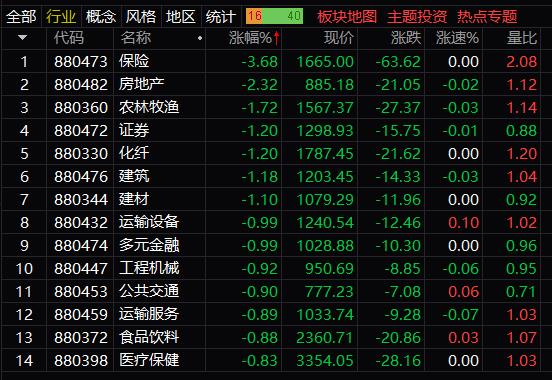The three major stock indexes of A-shares fluctuated slightly in the morning, and the decline was slightly enlarged in the afternoon. At the close, the Shanghai Composite Index reported 3,043 points, down 0.40%, the Shenzhen Stock Exchange Index reported 9,604 points, down 0.27%, and the Growth Enterprise Market Index reported 1,895 points, down 0.579%. The turnover of the two cities broke through another trillion yuan.
In terms of sectors: Internet, media and entertainment, software services, automobiles, Sora concepts are relatively better, while non-ferrous metals, electricity, components, petroleum and other sectors closed up;

On the decline list, insurance, real estate, agriculture, forestry, animal husbandry and fishery, brokerage and building materials were among the top losers.

Capital flow: As of the closing of A-shares, statistics show that northbound capital has bought a total of 1.567 billion yuan, of which Shanghai Stock Connect bought 649 million yuan and Shenzhen Stock Connect bought 918 million yuan. The turnover of northbound funds was 135.776 billion yuan, accounting for 12.87% of the total turnover of A shares, and the trading activity decreased by 13.03%, of which Shanghai Stock Connect bought 31.544 billion yuan and sold 30.895 billion yuan, while Shenzhen Stock Connect bought 37.128 billion yuan and sold 36.210 billion yuan. Northbound funds kept net purchases for four consecutive days, with net purchases of 6.001 billion yuan, 10.260 billion yuan, 4.244 billion yuan and 1.567 billion yuan respectively, with a total net purchase of 22.072 billion yuan.
Regarding the trend of A-shares, Guosheng Securities believes that as the "combination boxing" of stabilizing the capital market continues to land, economic data will be released in March or will exceed expectations, which will significantly boost risk appetite and investor confidence and drive the market risk appetite to rebound. The rebound is not over yet. If there is a shock adjustment in the short term or a benign adjustment on the way up. In the medium term, with the intensive introduction of steady growth policies, the process of economic recovery is expected to accelerate, and incremental funds may return to the rebound stage, and the amount of attention can be simultaneously enlarged. At the same time, after the registration system is fully implemented, its survival of the fittest mechanism will help the market style tend to be "blue-chip", and the intermediate market of the Shanghai Composite Index will not be absent but will only deepen. At present, it is suggested to maintain a balanced allocation with value slightly greater than growth.
Huajin Securities pointed out that blue-chip stocks are dominant and balanced. (1) Style: In the second quarter, it shifted from micro-stocks to super-large stocks and small and medium-sized stocks; The simultaneous strengthening of dividends and technology may continue in the short term, and the short-term growth and value are balanced; In the medium term, it may be biased towards technology and growth. (2) Based on the macro-environment orientation, profit and prosperity expectation orientation, PB-ROE orientation and PEG orientation, it is suggested to pay attention in the second quarter: First, TMT, Electric Power, Machinery, Automobile, etc. with upward profit and prosperity and high valuation cost performance; Second, buildings, banks, transportation and consumption that benefit from policy and economic restoration.
关于作者